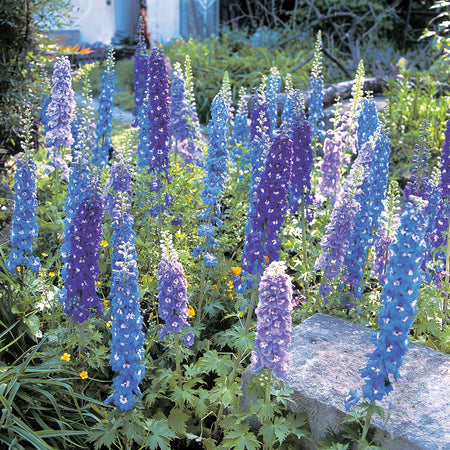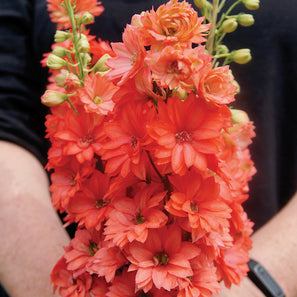AURORA SERIES MIX
Product Description:
The color and beauty of a flower garden can lift the spirit and renew the soul, and a bouquet of fresh cut flowers will bring sunshine into your home. Over the years we have conducted extensive flower trials, concentrating on varieties that are easy to grow-many from direct-sowing- have superior color and fragrance, and make a good cut flower. Take a bit of time, relax and enjoy a cup of steaming hot chocolate, and look over our selections. We think you'll find just what you're looking for.
Germination Codes
Given at the end of each description to give you specific information.
(1) Germination occurs between 70-85°F and within 6-15 days. Sow indoors and cover lightly.
(2) Needs a period of pre-chilling. Mix seeds with moistened peat moss and place in plastic bag. Seal and place bag in an area where the temperature is around 60°F for 2-3 days. Then place in the refrigerator for 30-90 days. After pre-chilling, place seed on sterile seedling mix and cover lightly. Germination may take up to 30 days.
(3) Needs darkness to germinate. Remove cover as soon as germination occurs.
(4) Direct sow in the garden as soon as the soil warms to at least 55°F.
(5) Germination may be slow and erratic. A fluctuating temperature of 75°F during the day and 50°F at night may help.
(6) Needs at least 12 hours of light per day to germinate. Press into the medium but do not cover. Keep moist.
Note: For those varieties that indicate a (1) or (6), a very light covering of vermiculite will allow adequate light to the seed and keep it uniformly moist.
Culture
• As a general rule, flowers can be sown when soil has warmed to at least 55°F
• Apply 1-2 cups of TSC's Complete fertilizer per 5 row feet, and 1 inch of compost
• If you prefer to soak your seeds: soak in 85°F water for 1-3 hours and plant immediately — longer soaking times are often detrimental; seeds need air to live
Direct Sowing
• Seeds should be buried 2 times their narrowest dimension and covered with finely raked soil or vermiculite unless otherwise noted
• Some varieties can take over a month to germinate so mark your rows, keep them moist, and for larger seeds like sunflowers, use bird netting
Transplanting
• Sow 5-6 weeks prior to anticipated transplant date
• If seeds need darkness, cover with 2 sheets of newspaper or plastic, remove upon the first signs of germination
• We recommend feeding your seedlings Age Old Grow, diluted to 1/4 strength
Insects & Disease
• Early watering and good weed control will generally alleviate most problems
• Pyrethrin will control most insects
Harvest & Storage
• For fresh-cut flowers: Harvest in the morning when flowers are their freshest and petals are just opening
• Cut with a clean knife that has been dipped in a solution of 10% household bleach
• A few drops of bleach in the vase will prolong their beauty
Delphinium Plant Care
Initial Instructions
After unpacking, allow the plant a few days to gradually acclimate to full exposure. Select a location in full sun to light shade with well-drained soil that’s rich in organic matter. If you have heavy, clay soil, we recommend amending it with compost to improve the drainage and add organic matter. If you choose to keep your plant in a container, up-pot to at least a 3-5 gallon pot and use a good quality potting mixture. There is no need to pinch the young plant, as it has a naturally sturdy, well-branched, compact habit.
Cultivation
Red Lark thrives in containers and directly in the landscape. Water regularly to irrigate the roots but allow the soil to dry halfway between waterings. Removing spent blooms to encourage the plant to continue producing flowers. Red Lark is a sterile hybrid and will not reseed. Fertilize with a well-balanced fertilizer in early spring when new growth appears. For containerized plants, increase the pot size as the plant grows. A mid-season of bloom formula fertilizer can help keep the plants showy. It’s best to transplant or up-pot the plants in early spring or when they are dormant in fall/winter. The plants will die back to the ground after the first hard frost and re-emerge in spring.
Size at Maturity
24—28 inches tall and 16-18 inches wide.
Pests & Diseases
Kept healthy, Red Lark is generally pest and disease free. If stressed, you may notice thrips, white fly, spider mites or aphids. Treat with Neem Max or our Super Soap and follow label directions.
Soil Type
Well-drained soil that’s rich in organic matter.
Light Requirements
Full sun to part shade.
USDA Zone
5a-8b



